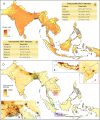Assessing the population at risk of Zika virus in Asia - is the emergency really over?
- PMID: 29082009
- PMCID: PMC5656141
- DOI: 10.1136/bmjgh-2017-000309
Assessing the population at risk of Zika virus in Asia - is the emergency really over?
Abstract
On November 18, 2016, the WHO ended its designation of the Zika virus (ZIKV) epidemic as a Public Health Emergency of International Concern (PHEIC). At the same time, ZIKV transmission continues in Asia, with the number of Asian countries reporting Zika cases increasing over the last 2 years. Applying a method that combines epidemiological theory with data on epidemic size and drivers of transmission, we characterised the population at risk of ZIKV infection from Aedes aegypti mosquitoes in 15 countries in Asia. Projections made under the assumption of no pre-existing immunity suggest that up to 785 (range: 730-992) million people in Asia would be at risk of ZIKV infection under that scenario. Assuming that 20% of ZIKV infections are symptomatic, this implies an upper limit of 146-198 million for the population at risk of a clinical episode of Zika. Due to limited information about pre-existing immunity to ZIKV in the region, we were unable to make specific numerical projections under a more realistic assumption about pre-existing immunity. Even so, combining numerical projections under an assumption of no pre-existing immunity together with theoretical insights about the extent to which pre-existing immunity may lower epidemic size, our results suggest that the population at risk of ZIKV infection in Asia could be even larger than in the Americas. As a result, we conclude that the WHO's removal of the PHEIC designation should not be interpreted as an indication that the threat posed by ZIKV has subsided.
Keywords: arboviruses; dengue; epidemiology; medical entomology; public health.
Conflict of interest statement
Competing interests: None declared.
Figures



Similar articles
-
Threats of Zika virus transmission for Asia and its Hindu-Kush Himalayan region.Infect Dis Poverty. 2018 May 15;7(1):40. doi: 10.1186/s40249-018-0426-3. Infect Dis Poverty. 2018. PMID: 29759076 Free PMC article.
-
Elevation as a proxy for mosquito-borne Zika virus transmission in the Americas.PLoS One. 2017 May 24;12(5):e0178211. doi: 10.1371/journal.pone.0178211. eCollection 2017. PLoS One. 2017. PMID: 28542540 Free PMC article.
-
Zika--an emerging infectious disease. The risk assessment from Polish perspective.Przegl Epidemiol. 2016;70(1):1-6, 93-7. Przegl Epidemiol. 2016. PMID: 27344465 English, Polish.
-
Zika virus: a new pandemic threat.J Infect Dev Ctries. 2016 Mar 31;10(3):201-7. doi: 10.3855/jidc.8350. J Infect Dev Ctries. 2016. PMID: 27031450 Review.
-
Zika Virus: Implications for Public Health.Clin Infect Dis. 2016 Jul 15;63(2):227-33. doi: 10.1093/cid/ciw210. Epub 2016 Apr 5. Clin Infect Dis. 2016. PMID: 27048745 Review.
Cited by
-
Knowledge and attitude towards pregnancy-related issues of Zika virus infection among general practitioners in Indonesia.BMC Infect Dis. 2019 Aug 6;19(1):693. doi: 10.1186/s12879-019-4297-4. BMC Infect Dis. 2019. PMID: 31387537 Free PMC article.
-
Downgrading disease transmission risk estimates using terminal importations.PLoS Negl Trop Dis. 2019 Jun 14;13(6):e0007395. doi: 10.1371/journal.pntd.0007395. eCollection 2019 Jun. PLoS Negl Trop Dis. 2019. PMID: 31199809 Free PMC article.
-
Mapping the cryptic spread of the 2015-2016 global Zika virus epidemic.BMC Med. 2020 Dec 17;18(1):399. doi: 10.1186/s12916-020-01845-x. BMC Med. 2020. PMID: 33327961 Free PMC article.
-
Serologic Tools and Strategies to Support Intervention Trials to Combat Zika Virus Infection and Disease.Trop Med Infect Dis. 2019 Apr 19;4(2):68. doi: 10.3390/tropicalmed4020068. Trop Med Infect Dis. 2019. PMID: 31010134 Free PMC article. Review.
-
Temperature impacts on dengue emergence in the United States: Investigating the role of seasonality and climate change.Epidemics. 2019 Sep;28:100344. doi: 10.1016/j.epidem.2019.05.003. Epub 2019 Jun 5. Epidemics. 2019. PMID: 31175008 Free PMC article.
References
-
- World Health Organization. Fifth meeting of the Emergency Committee under the International Health Regulations (2005) regarding microcephaly. other neurological disorders and Zika virus . 2016. http://www.who.int/mediacentre/news/statements/2016/zika-fifth-ec/en/ (accessed 24 Nov 2016).
-
- World Health Organization. Zika risk assessment in the Western Pacific Region . 2016 http://www.wpro.who.int/outbreaks_emergencies/zika/WPR_Zika_RiskAssessme....
Publication types
Grants and funding
LinkOut - more resources
Full Text Sources
Other Literature Sources
Research Materials
